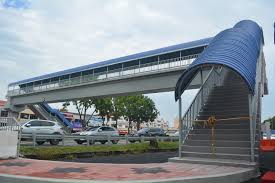Enhancing Road Safety

Overpasses are a crucial part of urban infrastructure, designed to separate different streams of traffic and provide safe crossings for both pedestrians and vehicles. In Malaysia, where road congestion and traffic accidents remain prevalent, overpasses play an important role in reducing the risk of collisions while also improving the overall flow of traffic.
An overpass is a bridge or elevated structure that allows traffic or pedestrians to cross over a road, railway, or another path without disrupting the flow of the vehicles below. Overpasses are typically built in areas with heavy traffic, complex intersections, or high volumes of pedestrian movement. They offer a safe, efficient alternative to at-grade crossings, which are more prone to accidents.
Overpasses provide multiple advantages in terms of both safety and traffic management. One of the primary functions of an overpass is to separate pedestrians and vehicles. Pedestrian-related accidents are a common occurrence at ground-level crossings, and overpasses offer a safe alternative, ensuring that foot traffic does not come into direct contact with moving vehicles. Additionally, overpasses help manage traffic by reducing the number of intersections and at-grade crossings. Vehicles no longer need to stop or slow down for pedestrians or cross-traffic, allowing for smoother traffic movement, particularly on highways or major roads.
Furthermore, overpasses alleviate traffic congestion by diverting traffic from intersections or congested areas, which is especially important during peak hours when traffic is at its highest. Although the initial cost of building an overpass may be high, it offers long-term savings by reducing accident-related costs, improving traffic efficiency, and minimizing wear and tear on lower-level roads.
In Malaysia, overpasses are widely used in major cities like Kuala Lumpur, Penang, and Johor Bahru to manage traffic and improve road safety. Highways such as the North-South Expressway and busy urban roads feature numerous overpasses to provide uninterrupted travel for vehicles while allowing pedestrians safe access to cross busy roads. For instance, in Kuala Lumpur, overpasses connecting shopping districts, transportation hubs, and residential areas have been key in reducing pedestrian accidents. By offering elevated crossings for foot traffic, these overpasses prevent jaywalking and other unsafe pedestrian practices that often lead to accidents.
Despite the benefits, there are certain challenges to constructing and maintaining overpasses. Building overpasses requires significant investment, particularly in urban areas where land acquisition and construction costs can be high. Additionally, overpasses can sometimes detract from the visual appeal of urban areas or disrupt natural landscapes, making it essential to consider the environmental impact and design overpasses that blend with the surrounding architecture. Maintenance is another crucial factor; like any infrastructure, overpasses require regular upkeep to remain safe and effective. Without proper maintenance, wear and tear can lead to structural issues that may pose safety risks.
As cities continue to grow, the demand for overpasses will only increase. The Malaysian government, in partnership with local authorities, is exploring advanced designs that are both functional and aesthetically pleasing. Furthermore, integrating pedestrian-friendly elements such as escalators, lifts, and covered walkways can make overpasses more accessible, encouraging safer crossing practices.
In conclusion, overpasses are a vital component of road safety infrastructure in Malaysia, offering both safety and efficiency benefits. By reducing pedestrian-vehicle interaction and improving traffic flow, overpasses help lower accident rates while addressing congestion in busy urban areas. For road safety systems like RAMS, highlighting the importance of overpasses can help cities better plan and implement these structures, making roads safer for everyone.

